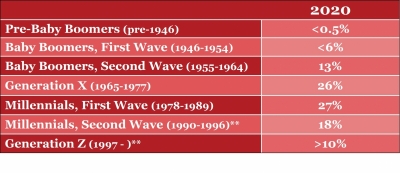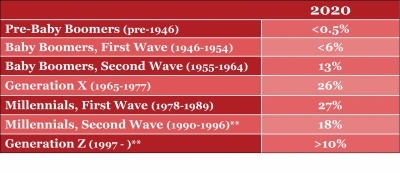Every day in North America, 10,000 Baby Boomers turn 65. The oldest Boomers in the workplace are 74. Millennials alone now comprise 45 percent of the workforce, Generation Z is rapidly on the rise, and Generation X is far too often left out of the conversation.
This is the numbers problem facing everyone—employers, employees, leaders, and managers—in 2020.
Generations in the 2020 Workforce
Based on the model developed by my firm, RainmakerThinking, there continue to be six generations working side by side in 2020, though just barely.

NOTE: The definition of emerging generations is always somewhat in flux. We have adjusted our research to reflect the birth-year definitions for Second Wave Millennials and Generation Z according to those used by the Pew Research Center.
The trends, percentage-wise, are similar throughout Europe and Japan. The percentage of young workers is much, much larger in Africa, Latin America, and much of Asia. In those parts of the world, people born 1990 and later comprise more than 60 percent of the workforce in 2020. The workforce is increasingly global across generations, but a much greater percentage of the new young global workforce will come from outside of North America, Europe, and Japan.
This is what I call the Great Generational Shift, a trend I have been tracking in the workplace since 1993.
Human Capital Management Is More Complex than Ever
It is understandable that these numbers would cause anxiety in many organizations. Retiring Boomers take with them valuable relationships and wisdom when they leave, both of which are tricky to pass on to colleagues. Employers may be wondering who in their organization is truly qualified enough—let alone loyal enough—to replace these older, more experienced employees.
Human capital management challenges are more complex and challenging than ever.
Resources for succession planning and leadership development are scarce, yet many employers find it difficult to invest those resources wisely. Careers no longer follow predictable, hierarchical paths. Organizations know they must be flexible in order to adapt, but the pace of change today means that is more difficult than ever before. Increasingly, everyone in the workplace is being asked to do more with less.
Yet at the same time, employees are no longer content to lay low in a sink-or-swim environment. They are asking for more. Norms in the workplace are changing—for everyone—and things such as flexibility and culture are in greater demand. Balancing these arrangements with business needs is an added challenge for leaders.
It can be easy to reduce these challenges to generational stereotypes in an effort to find solutions. But don’t fall into the trap.
You Cannot Manage with a Generational Cheat Sheet
Most people think of generational change in the workplace as a diversity issue. Some experts will give employers a checklist or cheat sheet for each generation, outlining how to attract, hire, retain, and manage people based on birthdate.
I think that’s misguided.
Imagine using any other diversity lens that way. Simply, it would be offensive. Using a checklist or cheat sheet approach glosses over the fact that there are as many stories within each generation as there are people.
So why do I continue studying the six generations working side by side today?
Because my research has taught me this: The real punchline of the Great Generational Shift is that employers must rethink human capital management. Gimmicks aren’t enough to engage and retain great employees of any age. Back-to-fundamentals leadership is what works.
Because of the incredible pace of change today, younger generations are not “growing up” and “settling down.” Rather than younger generations adopting the wisdom of those who came before, older generations are adopting the wisdom and experience of their younger peers. This is because the macro and micro forces driving the pace of change and business environment of the 21st century affect everyone equally.
The real diversity lessons of the Great Generational Shift are these:
- One-size-fits-all doesn’t work anymore.
- There are powerful trends impacting everyone of all ages—generations are more “alike” than you may think.
- The key to engaging and retaining the best talent today is to take it one person at a time, one day at a time—situational leadership based on who, why, what, where, and how an individual should be managed in order to do his or her best work.
Learn more about my latest generational research in the white paper: “The Great Generational Shift—2020 Edition.”
Bruce Tulgan is a best-selling author and the founder and CEO of RainmakerThinking, a management research and training firm. He is the author of numerous books, including “It’s Okay to Be the Boss,” “Not Everyone Gets a Trophy,” and “The 27 Challenges Managers Face.” His newest book, “The Art of Being Indispensable at Work,” is due for release in the summer of 2020 from Harvard Business Review Press. You can follow Bruce on Twitter @BruceTulgan or visit his website at rainmakerthinking.com.

